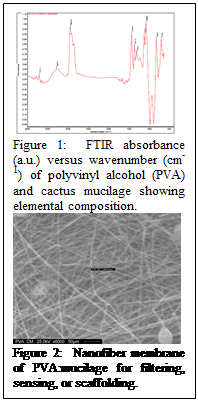Composition of Organic and Inorganic Polymeric Nanofibers for Filtering, Tissue Scaffolding, Wavelength Reflecting, and Self-healing Functionalities
Sylvia W. Thomas, Assistant Professor
Department of Electrical Engineering
University of South Florida, Tampa, Florida 33620-5350
sylvia@usf.edu;813.974.4011
 Overview of the Thomas research group: The Thomas group works primarily in the area of advance materials for bio and electronic integration research (AMBIR). The AMBIR lab currently focuses on the fabrication of electrospun nanofiber membranes used for biomedical, alternative energy, sustainable environment, and military devices. This interdisciplinary research explores the use of inorganic and organic nanofibers from the micro to the nano scale. The emphasis is on the production of sustainable nanofiber membranes with enhanced functionality and minimal environmental impact. Sustainable defined here as either reusable, biodegradable, or recyclable. By analyzing the chemical composition of nanofiber precursor solutions using Fourier transform infrared spectroscopy (FTIR) and characterizing structural defects using scanning (SEM) and transmission (TEM) electron and atomic force (AFM) microscopy, these data can be correlated to levels of membrane functionality. These membranes can function as environmental detectors, implantable sensors, tissue scaffolds, thermally reflective coatings, piezoelectric energy generators, biological filters, flexible electronics, or self-healing structures.
Overview of the Thomas research group: The Thomas group works primarily in the area of advance materials for bio and electronic integration research (AMBIR). The AMBIR lab currently focuses on the fabrication of electrospun nanofiber membranes used for biomedical, alternative energy, sustainable environment, and military devices. This interdisciplinary research explores the use of inorganic and organic nanofibers from the micro to the nano scale. The emphasis is on the production of sustainable nanofiber membranes with enhanced functionality and minimal environmental impact. Sustainable defined here as either reusable, biodegradable, or recyclable. By analyzing the chemical composition of nanofiber precursor solutions using Fourier transform infrared spectroscopy (FTIR) and characterizing structural defects using scanning (SEM) and transmission (TEM) electron and atomic force (AFM) microscopy, these data can be correlated to levels of membrane functionality. These membranes can function as environmental detectors, implantable sensors, tissue scaffolds, thermally reflective coatings, piezoelectric energy generators, biological filters, flexible electronics, or self-healing structures.
Teacher Project: Preparation of Polymeric Nanofiber Solutions for Correlation Tracking to Membrane Function
The goal of this project for the teacher is to prepare polymeric solutions (e.g. polyvinyl alcohol (PVA), polycarbonate polyurethane (PCPU), polystyrene (PS)) documenting volume/volume and/or weight/weight measurements, mixing and heating parameters (time, temperature, speed) for solution consistency and equilibrium. The teacher will assist a current Ph.D. student in electrospinning the solution to fabricate nanofiber membranes. Membranes will be characterized (e.g. FTIR SEM, AFM, TEM) at the USF Nanomanufacturing Research and Education Center (NREC) clean room. The teacher will observe the testing of specified nanofiber membranes for filtering (PS:mucilage), cell culturing/tissue scaffolding (PVA:mucilage), wavelength reflecting (PS:CoATO) or self-healing (PCPU) functionality. The teacher will document, in a database, the correlation of solution compositions to membrane production to the level of functional performance; and then analyze the results. The measurements of composition correlation data collected by the teacher will be of critical value when integrating and testing these novel membranes in devices. More specifically, this correlation data of chemical composition-to-membrane function can be used as inputs to an environmental impact assessment software. This will be useful in the long-term goal of the AMBIR Lab to evaluate the fabrication and utilization of sustainable nanofiber membrane devices. In collaboration with Masters and Ph.D. students, the teacher will prepare a weekly progress report for research meetings.
All facilities will be in-place for the teacher to start the project immediately. The first few days will be spent on re-reading a few relevant journal articles (sent before summer program start), understanding the details of the project, becoming familiar with research equipment to be used e.g. electrospinner, outlining a potential journal paper, and meeting with Dr. Thomas. Depending upon progress, co-authorship of a conference presentation or a journal article is possible for the teacher from this project.
- 1. Upconversion Photocatalysis for Energy and Environmental Applications
- 2. Sorption of Organic Vapors by Polymers using a Quartz Crystal Microbalance
- 3. Effective Deposition and Spreading of Powder Layers for 3D Printing
- 4. Synthesis and Characterization of Structured Nanomaterials for Energy Applications
- 5. Syntheses and Characterizations of Catalytically Active Porous Metal-Organic Frameworks (MOFs)
- 6. Microfluidic Filtration of Circulating Tumor Cells
- 7. Simulation and Rational Design of Metal-Organic Materials
- 8. Composition of Organic and Inorganic Polymeric Nanofibers for Filtering, Tissue Scaffolding, Wavelength Reflecting, and Self-healing Functionalities
- 9. Dynamic Tissue Cultures for Cell Printing
- 10. Synthesis and Characterization of Nanocomposites for 3D Printed RF Devices